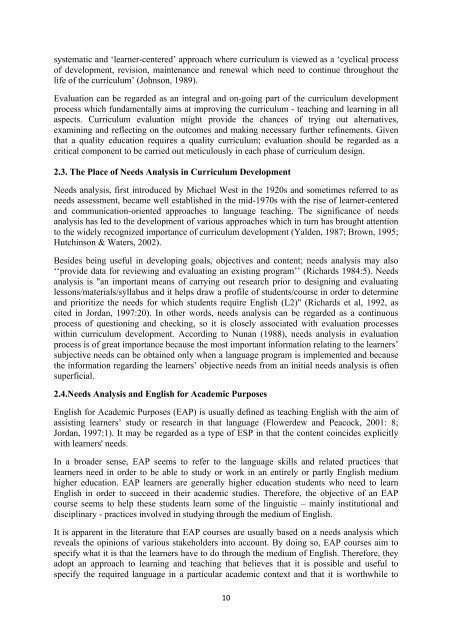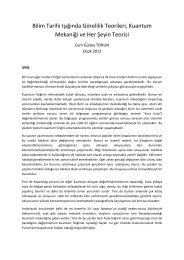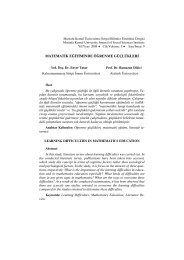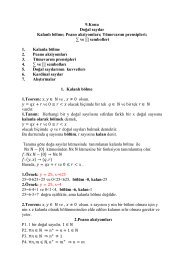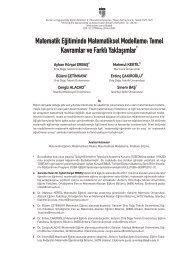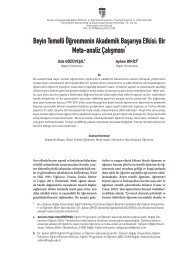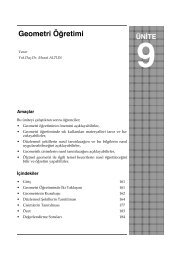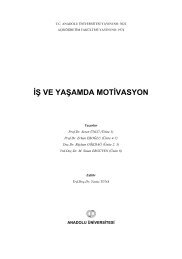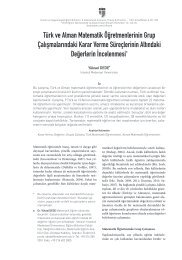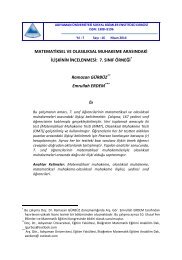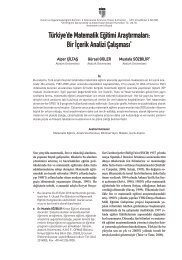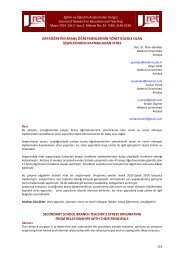Ufuk-U_niversitesi-SBE-Dergisi-S-ayı-5-kopya
Ufuk-U_niversitesi-SBE-Dergisi-S-ayı-5-kopya
Ufuk-U_niversitesi-SBE-Dergisi-S-ayı-5-kopya
Create successful ePaper yourself
Turn your PDF publications into a flip-book with our unique Google optimized e-Paper software.
systematic and ‘learner-centered’ approach where curriculum is viewed as a ‘cyclical processof development, revision, maintenance and renewal which need to continue throughout thelife of the curriculum’ (Johnson, 1989).Evaluation can be regarded as an integral and on-going part of the curriculum developmentprocess which fundamentally aims at improving the curriculum - teaching and learning in allaspects. Curriculum evaluation might provide the chances of trying out alternatives,examining and reflecting on the outcomes and making necessary further refinements. Giventhat a quality education requires a quality curriculum; evaluation should be regarded as acritical component to be carried out meticulously in each phase of curriculum design.2.3. The Place of Needs Analysis in Curriculum DevelopmentNeeds analysis, first introduced by Michael West in the 1920s and sometimes referred to asneeds assessment, became well established in the mid-1970s with the rise of learner-centeredand communication-oriented approaches to language teaching. The significance of needsanalysis has led to the development of various approaches which in turn has brought attentionto the widely recognized importance of curriculum development (Yalden, 1987; Brown, 1995;Hutchinson & Waters, 2002).Besides being useful in developing goals, objectives and content; needs analysis may also‘‘provide data for reviewing and evaluating an existing program’’ (Richards 1984:5). Needsanalysis is "an important means of carrying out research prior to designing and evaluatinglessons/materials/syllabus and it helps draw a profile of students/course in order to determineand prioritize the needs for which students require English (L2)" (Richards et al, 1992, ascited in Jordan, 1997:20). In other words, needs analysis can be regarded as a continuousprocess of questioning and checking, so it is closely associated with evaluation processeswithin curriculum development. According to Nunan (1988), needs analysis in evaluationprocess is of great importance because the most important information relating to the learners’subjective needs can be obtained only when a language program is implemented and becausethe information regarding the learners’ objective needs from an initial needs analysis is oftensuperficial.2.4.Needs Analysis and English for Academic PurposesEnglish for Academic Purposes (EAP) is usually defined as teaching English with the aim ofassisting learners’ study or research in that language (Flowerdew and Peacock, 2001: 8;Jordan, 1997:1). It may be regarded as a type of ESP in that the content coincides explicitlywith learners' needs.In a broader sense, EAP seems to refer to the language skills and related practices thatlearners need in order to be able to study or work in an entirely or partly English mediumhigher education. EAP learners are generally higher education students who need to learnEnglish in order to succeed in their academic studies. Therefore, the objective of an EAPcourse seems to help these students learn some of the linguistic – mainly institutional anddisciplinary - practices involved in studying through the medium of English.It is apparent in the literature that EAP courses are usually based on a needs analysis whichreveals the opinions of various stakeholders into account. By doing so, EAP courses aim tospecify what it is that the learners have to do through the medium of English. Therefore, theyadopt an approach to learning and teaching that believes that it is possible and useful tospecify the required language in a particular academic context and that it is worthwhile to 10


